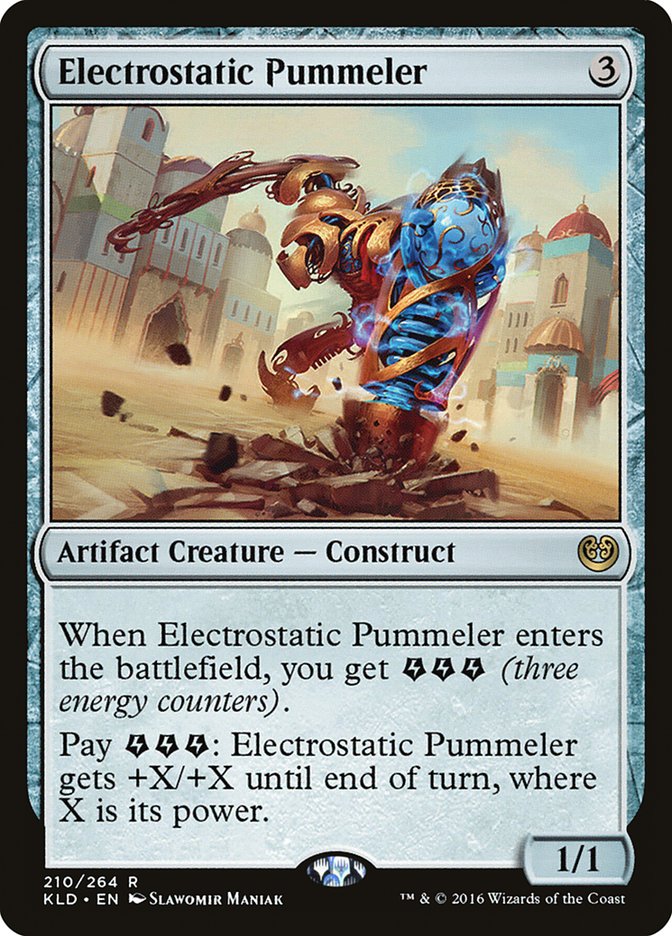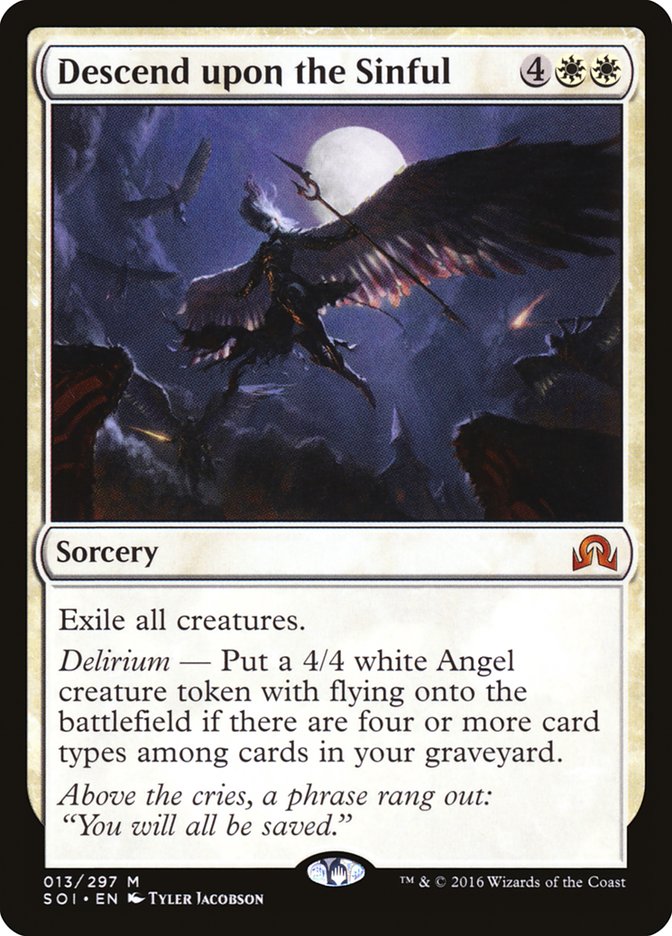I’m always excited for any major event, whether it is the old Magic Invitational, the World Magic Cup, the Legacy Championship, or the SCG Tour Players’ Championship. Give me some high-profile Magic, and I’m excited to see what people come up with.
And so the lead-in to this last weekend was pretty exciting for me, with the possibility that any one of the competitors might be bringing decks to the table that could shift the reality of the metagame. While I interested in all of the formats, the one that held the strongest interest for me was Standard.
These cards have largely made the Standard metagame one that is highly dominated by B/G Delirium, W/U Flash, and Temur Aetherworks, with the occasional incursion by a deck like Mardu Vehicles or Panharmonicon. While this isn’t a perfect description of the metagame, it does seem fair to say that a lot of people are relying on a very few decks.
While we’re certainly going to see the world change more than a little bit with the advent of Aether Revolt, we’re still weeks away from the Prerelease, let alone events like PT Aether Revolt or the SCG Regionals in February. In the meantime, as much as I love things like the Holiday Cube, I want to be playing Standard. Anything that opens up the gates is always welcome.
Thank you, Joe Lossett, bringing the Energy beatdown.
In the Knockout Stage, Joe’s first two matches were against Andrew Jessup with Temur Aetherworks and then Todd Anderson with G/B Aggro before facing Caleb Scherer in a multi-format match (Modern and Legacy). While we didn’t see the finals play out in Standard, Scherer’s deck is quite similar to Jessup’s, and it wouldn’t have been surprising to see Joe’s Temur Energy duplicate the 2-0 victory from the quarterfinals.
If you haven’t yet seen Joe’s deck, check it out:
Creatures (20)
Lands (20)
Spells (20)
- 4 Uncaged Fury
- 3 Rush of Adrenaline
- 4 Larger Than Life
- 4 Blossoming Defense
- 4 Attune with Aether
- 1 Built to Smash
Sideboard

This deck is a huge return to what we saw at the last PT, PT Kaladesh, where G/R Energy was one of the big decks of the event. That deck didn’t do incredibly well at the Pro Tour and has since largely fell out of favor, but it is worth noting that, as metagames calcify, sometimes decks that weren’t necessarily well-received initially or even early on can come back, given the right circumstances.
It is certainly true that a small field like the Players’ Championship is not the same thing as the metagame in “the wild,” where it isn’t just the preferences of a small handful of players that matter, but the influence on a larger world. Hence, Joe’s finish is even more noteworthy when we see it replicated elsewhere:
Creatures (20)
Lands (8)
Spells (32)
- 9 Forest
- 2 Mountain
- 1 Uncaged Fury
- 4 Larger Than Life
- 4 Harnessed Lightning
- 4 Blossoming Defense
- 4 Attune with Aether
- 4 Built to Smash
Sideboard

This isn’t the exact same list that Joe ran, but it is entirely the same archetype, and it has many of the same traits that I think that makes Joe’s list noteworthy.
Joe, perhaps taking a cue from Mardu Vehicles, made the easy splash of blue entirely for the sideboard. Running the splash off six lands in the maindeck, Servant of the Conduit, and four Attune with Aether for the sideboard Island, getting the consistent blue is actually not all that hard. In return for the investment, there is quite a payoff in the form of Ceremonious Rejection and Negate.
Both of these cards allow the deck a kind of play that it wouldn’t have available if it stayed strictly G/R Energy. If you are running the actual countermagic, you get the opportunity to turn yourself into a true aggro-control deck in some matchups, rather than demanding that you simply play the powerless aggro deck that must race. If you’re facing down an Aetherworks Marvel, running a race can be difficult, since Woodweaver’s Puzzleknot and Harnessed Lightning can make establishing a kill quickly enough a real challenge, particularly when you also are throwing cards like Ishkanah, Grafwidow into the mix on the side of the defense. If you’re able to create a different dynamic, that is preferable. With the blue shift towards aggro-control, you’re no longer required to simply race your opponent and instead can simply slow up enough to make sure that they don’t win while you go about trying to kill them.
This shift is huge, and while it is possible that some players considered this move for their aggressive Energy-based decks at the Pro Tour, I don’t recall it. Certainly none of the players in the Mad Apple/Hot Sauce team alliance ended up with it, nor did anyone that I saw playing the deck in Hawaii.
This solves a huge problem that the deck would occasionally have: you’d play against an opponent, potentially able to threaten them with death in numerous moments in a match, but you couldn’t actually stop them from just going over the top of you.
Speaking of which, another thing I love about Joe’s deck is his commitment to potentially just killing you. Let’s compare Joe’s deck to the top-finishing Energy aggro deck from PT Kaladesh:
Creatures (22)
- 4 Tireless Tracker
- 1 Verdurous Gearhulk
- 4 Longtusk Cub
- 4 Voltaic Brawler
- 2 Lathnu Hellion
- 3 Bristling Hydra
- 4 Servant of the Conduit
Planeswalkers (2)
Lands (10)
Spells (26)

I want to state, first of all, that I still like Shaun McLaren’s deck. However, it doesn’t have one of the big traits that Joe’s deck does: consistently threatening the death of the opponent.
Where Shaun’s deck has the regular power and consistency that is supplied by a combination of vehicles and generally powerful spells, Joe’s has a bunch of bad cards in it. It just so happens that there are many ways these bad spells add up (or double up) to kill you. Shaun’s deck was from one of the earliest moments in the format, so I’m not knocking it; it simply probably isn’t a great choice now, where clearly Joe’s can do what’s needed to win today.
Electrostatic Pummeler and Uncaged Fury can do work with other cards to simply end the game. If an opponent isn’t prepared for it with an answer, the game can be simply over. Interestingly, these days, it feels like there are far fewer answers than there have been in the past. This makes the all-in approach far less scary than it might have otherwise been.
That’s not to say that Joe’s Temur Energy deck doesn’t have some actual staying power. Both Longtusk Cub and Bristling Hydra can play a fair game of “attack without tricks” quite well, and even Voltaic Brawler can manage the same feat, albeit not quite as long. The deck isn’t blisteringly fast without the explosive combo of a doubled power and a pump, but it is still potent.
Staying focused on the kill in the maindeck is a great choice. All of the answers are in the sideboard, thus letting your Game 1 shine as brightly as possible when your opponent is most likely the least prepared for it. Being single-minded like this is paid off much less often after your opponent can tailor their configuration to the reality of you as an opponent. In those situations, it can actually oftentimes be unwise to try for the all-in approach, and having a lot of answers can be huge.
It is unsurprising, then, that Joe’s sideboard is basically all answers (or at least ways to facilitate an answer). Galvanic Bombardment has emerged as one of the best anti-aggro cards out there. Tears of Valakut is a great card against any Archangel Avacyn silliness. Natural State is basically one of the best Naturalize effects out there if you don’t care about Aetherworks Marvel (and you have blue spells for that). Fourteen answers and an Island – given that you have sixteen non-mana spells in your maindeck, you have a lot of maneuvering that you can do, if you want to.
This leads to a very intriguing question that ends up being asked to the opponent over the course of a three game match: what kind of deck will you be facing?
If Game 1 comes out blisteringly scary, with the aggressive deck threatening to kill you at any moment, and Game 2 potentially shifts to a slower deck that has more answers and is more flexible, should there even be a Game 3, this Temur Energy deck can create quite a conundrum for an opponent. Do you shift your approach to the matchup to be more suited to the reactive slower deck or stay sideboarded for the fast deck you saw in Game 1? The ability to ask this kind of question is an uncommon thing, and it can place opponents in a difficult position. I’ve certainly played plenty of aggressive decks that were able to shift their roles successfully, and opponents stuck trying to figure out their sideboarding in this situation are in a difficult position.
While I love Joe Lossett’s deck, I also wanted to mention another energy-based deck, though I know it is a bit less intriguing to many because it is an Aetherworks Marvel deck. I want to talk about the Naya Aetherworks deck that Jacob Baugh ran back from the Invitational to the Players’ Championship, and how it appears to have inspired another Aetherworks Marvel deck that has tickled my fancy.
Here’s the Naya Aetherworks deck piloted by Baugh (and many others):
Creatures (12)
Planeswalkers (6)
Lands (9)
Spells (33)

A card that a lot of Aetherworks Marvel decks have sometimes used in order to clear their hand of valueless cards has been Chandra, Flamecaller. Personally, while I love this card, it isn’t necessarily a great card to clear the table of some of the larger creatures that B/G Delirium sometimes produces, like Ishkanah, Grafwidow or Mindwrack Demon, not to mention how poorly it looks versus a Selfless Spirit.
Weeks ago, seeing Jacob’s Nahiri, the Harbinger brought more than a bit of joy to my eyes.
Personally, I’ve loved Nahiri since it was first printed, and I loved the way that it looked in Jacob’s deck as a means to get rid of that extraneous Emrakul early on without having the great expense of a Chandra, Flamecaller or the general narrowness of a card like Cathartic Reunion.
From a perspective of spells, it is practically the same collection as you see in Temur Aetherworks decks, with only a tiny collection of different cards used to fit in Nahiri, the Harbinger, a choice that justifies the use of the full four Emrakul, the Promised End.
All of that leads to this build of Naya Aetherworks that really tickles my fancy:
Creatures (11)
Planeswalkers (4)
Lands (10)
Spells (35)

It’s not that this deck is necessarily a better build of a Nahiri-based Aetherworks Marvel deck than the version championed by Baugh. What I like is just having access to those copies of Descend upon the Sinful.
When your opponent casts an Emrakul and you show them a Descend upon the Sinful, it feels good.
Lately, I’ve been seeing so many copies of Emrakul, I’m down for feeling that kind of feeling.
But enough about an Aetherworks Marvel variation. Let’s get back to the main point:
Thanks, Joe, for giving me something better to do with energy than spin the wheel. I appreciate it! (And so should everyone else.)







